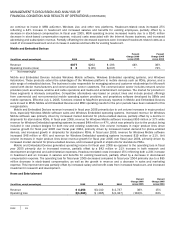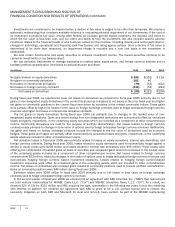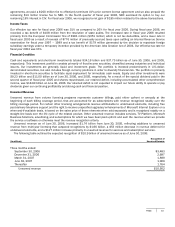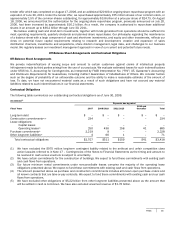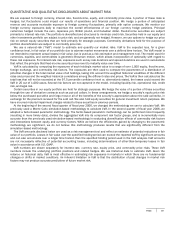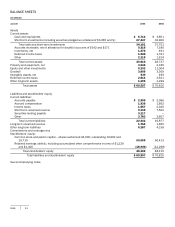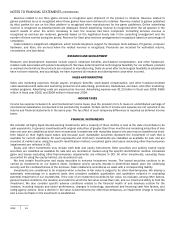Microsoft 2006 Annual Report Download - page 37
Download and view the complete annual report
Please find page 37 of the 2006 Microsoft annual report below. You can navigate through the pages in the report by either clicking on the pages listed below, or by using the keyword search tool below to find specific information within the annual report.
PAGE 36
MANAGEMENT’S DISCUSSION AND ANALYSIS OF
FINANCIAL CONDITION AND RESULTS OF OPERATIONS (CONTINUED)
RECENTLY ISSUED ACCOUNTING STANDARDS
In November 2005, the FASB issued Staff Position (“FSP”) FAS123(R)-3, Transition Election to Accounting for the Tax Effects of
Share-Based Payment Awards. This FSP requires an entity to follow either the transition guidance for the additional-paid-in-
capital pool as prescribed in SFAS No. 123(R), Share-Based Payment, or the alternative transition method as described in the
FSP. An entity that adopts SFAS No. 123(R) using the modified prospective application may make a one-time election to adopt
the transition method described in this FSP. An entity may take up to one year from the later of its initial adoption of SFAS
No. 123(R) or the effective date of this FSP to evaluate its available transition alternatives and make its one-time election. We
elected to adopt the transition method as described in the FSP as of July 1, 2005. This method change did not have an impact
on our financial statements.
In June 2006, the FASB issued FIN No. 48, Accounting for Uncertainty in Income Taxes – an interpretation of FASB
Statement No. 109, which clarifies the accounting for uncertainty in income taxes recognized in an enterprise’s financial
statements in accordance with FASB Statement No. 109, Accounting for Income Taxes. The interpretation prescribes a
recognition threshold and measurement attribute for the financial statement recognition and measurement of a tax position
taken or expected to be taken in a tax return. FIN No. 48 requires recognition of tax benefits that satisfy a greater than 50%
probability threshold. FIN No. 48 also provides guidance on derecognition, classification, interest and penalties, accounting in
interim periods, disclosure, and transition. FIN No. 48 is effective for us beginning July 1, 2007. We are assessing the potential
impact that the adoption of FIN No. 48 will have on our financial statements.
In June 2006, the FASB ratified the Emerging Issues Task Force (“EITF”) consensus on EITF Issue No. 06-2, “Accounting for
Sabbatical Leave and Other Similar Benefits Pursuant to FASB Statement No. 43”. EITF Issue No. 06-2 requires companies to
accrue the costs of compensated absences under a sabbatical or similar benefit arrangement over the requisite service period.
EITF Issue No. 06-2 is effective for us beginning July 1, 2007. The cumulative effect of the application of this consensus on prior
period results should be recognized through a cumulative-effect adjustment to retained earnings as of the beginning of the year
of adoption. Elective retrospective application is also permitted. We are currently evaluating the financial impact of this
guidance and the method of adoption that will be used.
APPLICATION OF CRITICAL ACCOUNTING POLICIES
Our financial statements and accompanying notes are prepared in accordance with U.S. GAAP. Preparing financial statements
requires management to make estimates and assumptions that affect the reported amounts of assets, liabilities, revenue, and
expenses. These estimates and assumptions are affected by management’s application of accounting policies. Critical
accounting policies for us include revenue recognition, impairment of investment securities, impairment of goodwill, accounting
for research and development costs, accounting for legal contingencies, accounting for income taxes, and accounting for stock-
based compensation.
We account for the licensing of software in accordance with American Institute of Certified Public Accountants Statement of
Position (“SOP”) 97-2, Software Revenue Recognition. The application of SOP 97-2 requires judgment, including whether a
software arrangement includes multiple elements, and if so, whether vendor-specific objective evidence (“VSOE”) of fair value
exists for those elements. Customers receive certain elements of our products over a period of time. These elements include
free post-delivery telephone support and the right to receive unspecified upgrades/enhancements of Microsoft Internet Explorer
on a when-and-if-available basis, the fair value of which is recognized over the product’s estimated life cycle. Changes to the
elements in a software arrangement, the ability to identify VSOE for those elements, the fair value of the respective elements,
and changes to a product’s estimated life cycle could materially impact the amount of earned and unearned revenue. Judgment
is also required to assess whether future releases of certain software represent new products or upgrades and enhancements
to existing products.
SFAS No. 115, Accounting for Certain Investments in Debt and Equity Securities, and SEC SAB 59, Accounting for Noncurrent
Marketable Equity Securities, provide guidance on determining when an investment is other-than-temporarily impaired.
Investments are reviewed quarterly for indicators of other-than-temporary impairment. This determination requires significant
judgment. In making this judgment, we employ a systematic methodology quarterly that considers available quantitative and
qualitative evidence in evaluating potential impairment of our investments. If the cost of an investment exceeds its fair value,
we evaluate, among other factors, general market conditions, the duration and extent to which the fair value is less than cost,
and our intent and ability to hold the investment. We also consider specific adverse conditions related to the financial health of


